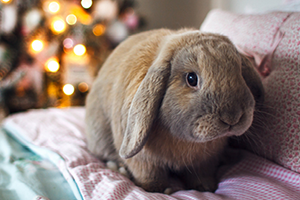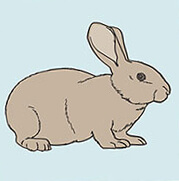As we head into the colder months, it’s time to…
Read more
Gentle, docile and irresistibly soft with a love of interaction
The snuggly, longhaired English Angora Rabbit is known for its luxuriously thick and fluffy coat, and makes a loveable, gentle pet.
Vital Stats
| Size: | Medium, weighing about 2-3kg (5-7lb). |
|---|---|
| Coat: | English Angoras’ thick coats need daily grooming to prevent matting, and will also need to be sheared a few times a year to encourage new hair growth and help maintain a healthy coat. |
| Life span: | 5-8 years. |
| Temperament: | Angoras are intelligent, gentle rabbits who love to play, especially with cat toys. Although they like to snuggle up to their handlers, they dislike being picked up and can become aggressive when frightened. Extra care must be taken when handling them as their spines are easily damaged. |
coat Temperament Gentle Life span 5-8years

common illnesses in a Angora
Common Angora Health Conditions
As a rabbit owner you will want what’s best for your pet’s health so they can live a long, happy life. Like all breeds, Angoras are prone to certain health conditions. To help you be more aware and prepared for these potential ailments if they should arise, we have put together information on the health issues that we see the most in Angoras.
Common Angora Health Conditions
Dental disease +
Many rabbits suffer from dental problems. Because rabbits’ teeth are constantly growing, they need a good, balanced diet with plenty of hay to help wear down teeth at an even rate.
English Angora Rabbits can suffer from mandibular prognathism, which leads to abnormal patterns of dental wear, causing elongated teeth or altered teeth positions. Symptoms include weight loss, dribbling or gut problems.
Vets can burr down teeth under anaesthetic to help improve misalignment and remove sharp spikes, which might dig into the sensitive tissues of the tongue and cheeks.
Parasites +
Parasites are a common problem among all breeds of rabbit. Cheyletiella mites in particular can cause itching and hair loss, but can be easily treated with anti-mite preparations in the form of an injection or spot-on treatment.
The E cuniculi parasite can be more difficult to treat. It’s spread by spores in the urine and can be passed on to other rabbits. Although some rabbits with the parasite are symptomless, others are more sensitive. Symptoms include excessive thirst and urination, cataracts, head tilt and paralysis in the back legs. Although the parasite can’t be removed entirely, symptoms can be managed with worming treatments.
In warm weather, rabbits may be prone to flystrike – where flies lay eggs in their fur, leading to a maggot infestation. Angoras may be more at risk of flystrike, as eggs can easily stick to their long fur or any tangles. Rabbits that are already unwell and aren’t grooming themselves properly are particularly at risk. With prompt intervention, treatment can be effective, but it’s important to address the reasons why flystrike occurred in the first place. For example, an inability to groom properly due to a pre-existing condition such as dental issues, obesity, diarrhoea or prolonged periods of inactivity.
Viral infections +
Viral infections can be spread between rabbits, either by spores in the urine, or by insects or animals contaminated by the virus. Viral haemorrhagic disease (VHD), sometimes also known as rabbit haemorrhagic disease, which has symptoms such as fever, lethargy, loss of appetite and spasms, and myxomatosis (symptoms include swelling and lesions around the rabbit’s head, face, ears, lips, anus and genitalia) are two such diseases, and can be spread by flies, fleas or mosquitoes.
While there is no known cure for these viral infections, they can be prevented with a vaccine. As the peak season for myxomatosis is between late summer and autumn, it’s advisable to vaccinate in spring or early summer. In the case of VHD, a new vaccination that targets newer strains of the virus is now widely available in the UK.
Once your rabbit has had the initial vaccination, speak to your vet about staying up to date with boosters each year.
Spinal injury +
English Angoras, like all rabbits, have extremely delicate spines. A frightened or startled rabbit may suddenly kick out with its hind legs, which can cause spinal damage from the force of the movement. Injuries can also occur if a rabbit is incorrectly handled or even dropped. Symptoms include paralysis of the hind legs, incontinence and lethargy.
Treatment depends on the severity of the fracture and the general wellbeing of the rabbit. If the injury has resulted in total paralysis of the hind legs and bladder incontinence, a vet may advise that putting the rabbit to sleep is the kindest option. Although spinal trauma cannot be cured, there are some procedures that can help correct an injury, as well as anti-inflammatory medication to address pain. Usually though, rabbits who have suffered a severe spinal fracture do not feel any pain at all.
Bladder problems +
Most animals only take in the calcium they need from their food and expel it through their guts, whereas rabbits absorb all the calcium they eat and expel it through their bladders. This can sometimes result in an excessive build-up of calcium, known as bladder sludge. Some rabbits, including Angoras, may develop bladder stones.
Symptoms include squealing or squeaking when passing urine, the presence of blood in the urine, or urine scald – where urine has been in contact with the rabbit’s skin for prolonged periods of time, causing a rash.
Luckily, these conditions are relatively straightforward to treat if caught early. Bladder stones can be surgically removed, while sludge can be treated with fluids to help flush out the bladder. If the rabbit also has cystitis (a bladder infection), a course of antibiotics will help to clear it up. Dietary changes, such as feeding good-quality pellets that ensure your rabbit gets just the right amount of calcium, can help prevent problems from occurring, too.
Angora insurance considerations
Angoras sometimes suffer with certain health conditions and may require treatment. Petplan rabbit insurance offers peace of mind that they will always be protected.
Get a Angora quote










